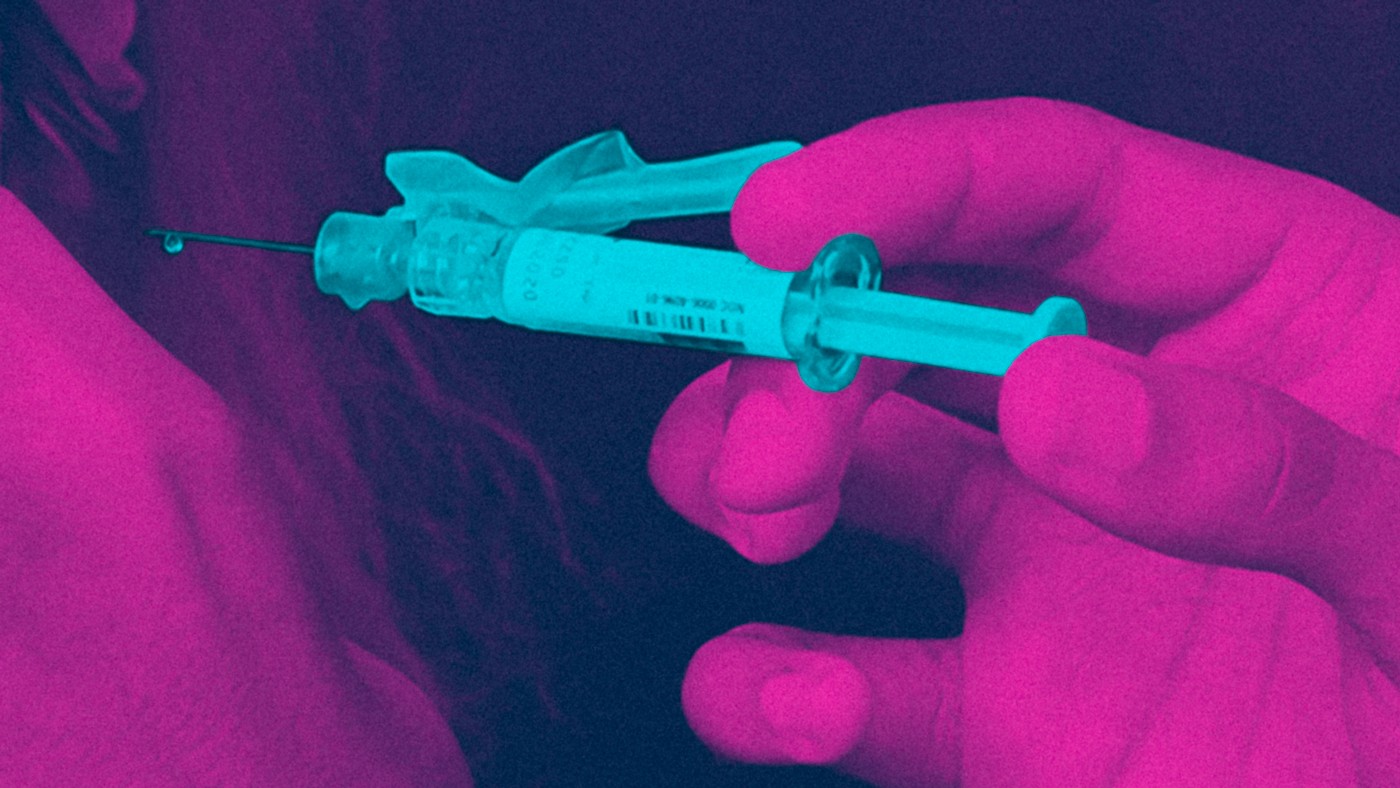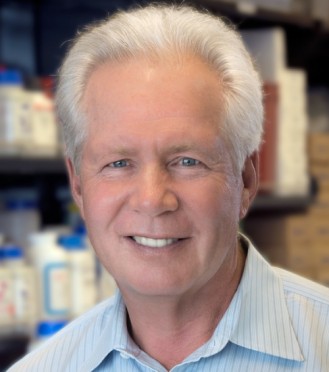Gladstone NOW: The Campaign Join Us on the Journey✕

As some people may still be deciding whether to get a COVID-19 vaccine, two of Gladstone's virologists answer some common questions. [Image adapted from “Young girl receiving a vaccine in her arm” by SELF Magazine as licensed under CC BY 2.0.]
As the United States advances toward the goal of administering at least one dose of vaccine to 70 percent of its adult population by July 4, 2021, the SARS-CoV-2 virus that causes COVID-19 seems to be in retreat. Many states are dropping masking and social distancing requirements, large public events are resuming in some areas, and companies are announcing plans for workers to return to their offices.
Dramatic declines in new infections, hospital admissions, and deaths are causes for celebration—but we still need to get more Americans vaccinated, say two virologists at Gladstone Institutes. They warn that limited vaccination rates in some parts of the country could spell trouble ahead, especially as immunity conferred by earlier surges of infection starts to wane. Though daily US case counts have dropped below 25,000, that’s still a lot of glowing embers available to touch off regional COVID-19 brushfires in the months ahead.
Recently, those two virologists—Melanie Ott, MD, PhD, director of the Gladstone Institute of Virology, and Warner Greene, MD, PhD, director of the Michael Hulton Center for HIV Cure Research—discussed current vaccine trends and shared information for people who may still be making a decision about vaccination.
1. Governments have lifted mandates and restrictions, the economy is roaring back, and people are going out into crowds unmasked. Is the pandemic danger really passed?
Ott: If the number of cases remains the same and doesn’t increase further, pockets of infection will remain. The virus is very adaptive, as we learned through the variants, and will continue to be a threat in the country and the world. While the vaccines are very effective, we have to make sure they have been taken. We have to be vigilant.
Greene: We are not completely out the woods yet, although the numbers are looking much better: dropping case counts, decreasing hospitalizations, and falling deaths. We are likely seeing the leading edge of herd immunity because roughly 50 percent of eligible adults have now been vaccinated, plus considerable natural immunity is present since the US holds the record as the most infected country in the world. Vaccine uptake is currently lagging in parts of the South and Mountain West––these are the areas where we need to continue high-level testing and contact tracing to prevent a major outbreak.
2. The CDC is urging people who have recovered from COVID-19 to be vaccinated. Does the vaccine provide better protection than natural immunity from the infection?
Greene: With a mild infection or an asymptomatic infection, individuals will develop some level of immunity, but far less than the immunity elicited by the two doses of the mRNA vaccines (from Pfizer-BioNTech and Moderna). No one anticipated the kind of double grand slam provided by these two vaccines—95 percent protection against any form of infection. Science has given us an amazing gift–– previously infected individuals should definitely get vaccinated.
Ott: We also know that the immunity from natural infection is limited in time, so it’s not a durable protection. People who have been infected should take advantage of the vaccine because it can put them into a super-immunity level.
3. One of the concerns raised by people hesitant to get the vaccine is that they don’t know what’s in the mRNA vaccines. Could you explain?
Greene: There are really only two things in the Pfizer-BioNTech and Moderna vaccines: a messenger RNA encoding the Spike protein of SARS-CoV-2 surrounded by a lipid (fat) nanoparticle. The mRNA contains the code that allows our cells to manufacture the viral Spike protein, and only that protein. The fat particle traps the mRNA, protects it from degradation and facilitates delivery of the RNA into our cells. While simple in concept, a great deal of trial and error was required to develop effective lipid nanoparticles. Once our cells produce the Spike protein, the immune system is primed and begins producing both Spike-specific antibodies and Spike-specific T cells. We know the vaccines lead to the production of long-lived memory B and T cells, but it is not yet clear how long the vaccines will protect us. If we start observing waning immunity and decreasing responses of the memory cells, it will be time for a booster shot.
Ott: I also think that many people are simply afraid of the shot. None of the symptoms are prohibitive or as serious as some of the complications that can result from a COVID-19 infection. And, many people don’t experience any symptoms after being vaccinated.
4. Publicity about individuals who were fully vaccinated, but got the virus anyway, may be raising doubts about the vaccine. Are these rare infections surprising?
Ott: Vaccine breakthrough infection is something that is expected. We know that the vaccine is 95 percent effective, but not 100 percent. These breakthrough infections are usually noticed not because people are symptomatic or end up in the hospital, but they are picked up through widespread testing. These infections are extremely mild in most, but not all, cases. We have a vaccine that prevents the COVID-19 disease, rather than preventing 100 percent of infection.
Greene: California has recently reported data on breakthrough infections in vaccinated individuals. Such breakthroughs are rare: 3,620 infections occurred in over 13.5 million vaccinated individuals, of which 150 required hospitalization, and 20 died. It’s important to keep in mind that those individuals may have died for reasons unrelated to COVID-19. These data further emphasize how effective these vaccines are.
5. What do you expect from the variants? Are they going to eventually overwhelm the vaccines?
Greene: I predict that the mRNA vaccines are going to stand up quite well against the variants that exist now, but variants could emerge that show higher levels of resistance to vaccine-induced immunity. There is a general debate in the scientific community about whether the coronavirus has already taken its best shot at avoiding our potent vaccines or whether there might still be new ways the virus can mutate to achieve higher level immune resistance. It is really important for us to continue to carefully monitor for new variants and assess their sensitivity to the current vaccines.
Ott: The key question now and in the immediate future is the global response. It needs to be a coordinated response, because otherwise we will have very disparate vaccination campaigns and efficacies around the world and we will deal with recurrence and variant development everywhere. That will inevitably come back to the United States and we really need to tackle it head-on in a very proactive way. The second thing we need to discuss more is that we might have to deal with a booster shot. This means we need to get everybody used to the vaccine as we—or at least some of us, possibly based on age—might have to take it more than once.
6. The speed at which the mRNA vaccines were created and rolled out has been breathtaking. Was the scientific community expecting this to happen so quickly?
Greene: One concern about the RNA vaccines is the fact that they were created so quickly and, at the same time, touted as so effective. Many people concluded this as too good to be true. One distinct advantage of the RNA vaccine technology is the speed with which a vaccine candidate can be produced for testing. It is important to note that absolutely no shortcuts were taken in testing and vetting these RNA vaccines. All of the companies did full clinical trials, including phase III testing involving tens of thousands of volunteers who received either a vaccine or a placebo in a blinded manner. The results were stunning. We all should take full advantage of this “get out of COVID-19 pandemic jail card” offered by the vaccines. Efforts are now underway to build on the success of the COVID-19 RNA vaccines by using this same technology to create vaccines for various pathogens including West Nile virus, cytomegalovirus, HIV, and many others.
Ott: We should not forget that the current vaccines build upon decades-long vaccine research. One factor that sped up the timeline to emergency approval was the financial support from governments. That removed much of the risk of developing vaccines for the companies, and accelerated the production and the clinical trials. Another factor is that a large number of volunteers could participate in clinical trials. Often, by the time a vaccine is ready, a localized outbreak has subsided and not enough infected people are available to gain conclusive results from a clinical trial. With the worldwide COVID-19 pandemic, this was obviously not the case.
7. The Pfizer-BioNTech vaccine was just authorized for adolescents 12 to 15 years old. How important will it be to vaccinate them and younger children when that is approved?
Greene: The virus treats adolescents who have reached puberty the same as it does adults. In middle school and elementary school, children are less susceptible to serious disease and they don’t seem to spread the virus much, but some of the variants are clearly attacking kids at higher rates than the original strain. In Brazil, huge numbers of kids are becoming sick and dying from this virus. The RNA vaccines are now approved for adolescents down to age 12. Studies of 5- to 11-year-olds are currently underway. Vaccinating our children will make a full-time return to school far easier to achieve.
Ott: It is important to get everybody, children included, vaccinated. This will prevent serious disease in children and will prevent the virus from circulating in schools and preschools and developing more mutations. With some of the variants now becoming more virulent in children, we need to remain vigilant. The most important thing is for these kids’ school and social life to return to normal.
8. We’ve spoken about the benefits of getting the Pfizer-BioNTech and Moderna vaccines. But what about the other vaccines available, some of which have been associated with serious side effects? Should people get those if they are available to them first?
Greene: The only other approved vaccine in the United States is from Johnson & Johnson. In this vaccine, SARS-CoV-2 Spike is delivered by an adenoviral vector (a harmless virus). A major advantage of this vaccine is that it works as a single shot and does not require super-cold storage. It should be an excellent vaccine for global distribution. Rare cases of major clotting in the brain or in the abdomen have been reported 6 to 13 days after vaccination, mainly in women aged 18 to 49. The frequency of such clotting events is 7 per 1 million vaccinated women (roughly the same risk as being hit by lightning in a year).
Ott: All vaccines that are approved in the US are effective and safe. The advantage of the Johnson & Johnson vaccine—only one shot being necessary—is attractive to many.
9. What is it going to take to increase the rate of vaccination in the US, which seems to be slowing now, and why is that important to do?
Ott: We’re at the stage now where we have to become creative in the vaccine rollout to reach people who have not been vaccinated. The president set a goal to have 70 percent of Americans receive at least one dose of a vaccine by July 4, and we all need to actively help with this. Reaching out to people who are hesitant and engaging with schools and colleges in states with low vaccination rates is key now to prevent new surges in the fall, as many predict. Vaccines are driving the infection rates down in the US and are helping us to reopen. We are envied by everybody in the world for free access to vaccines—we should ALL take advantage of this.
Greene: Incentives are appearing in multiple unsuspected places. For example, Krispy Kreme will give you a free donut if you have a vaccine card. There are million-dollar lotteries you can enter if you are vaccinated. West Virginia is giving out $100 savings bonds. These are all creative approaches to increase levels of immunity throughout the US. The B1.1.7 variant first identified in the United Kingdom is now the most prevalent form of the virus in the United States. This variant is more infectious and may be more virulent. It is attacking younger people. The vaccines hold up well against this variant but, of course, you need to get vaccinated to be protected. Another incentive for vaccination is to avoid post-COVID-19 syndrome that can occur even after a mild infection. Individuals with this syndrome often describe fatigue, brain fog, shortness of breath, cough, chest and joint pain, and headaches. Post-COVID-19 syndrome can be highly debilitating, but vaccinated individuals are protected from developing this syndrome.
10. We’ve seen some suggestions that herd immunity might not be attainable. Are we going to get there?
Greene: I believe the sharply falling rates of new infections in the United States represents the very beginning of herd immunity, created by both the country’s aggressive vaccination program and a high frequency of prior SARS-CoV-2 infections. That said, as variants exhibiting increased infectivity and/or immune resistance begin to dominate, an increased fraction of people with SARS-CoV-2 immunity will be needed to maintain herd immunity.
Ott: Currently, we are doing something right because our numbers keep falling, and more and more lives are being saved every day. The key is to keep our overall number of infections low—in the US and around the world—to avoid new variants. If the virus cannot replicate, it cannot make mutations. If we keep our infection numbers as low as possible and the vaccination rates as high as possible, we could make a difference and reach herd immunity.
11. If we’re vaccinated, are we actually safe being unmasked, particularly if we’re indoors or around unvaccinated people?
Greene: Yes, vaccinated individuals enjoy a high level of protection against SARS-CoV-2 indoors and outdoors. They are safe without a mask and there is no requirement for physical distancing. They also are highly unlikely to carry the virus in an asymptomatic manner and transmit this virus to unvaccinated individuals. For all of these reasons, the CDC has relaxed their masking recommendations, indicating that vaccinated individuals can resume normal, pre-pandemic activities. Of course, federal, state, or local regulations may still be in place and should be adhered to (for example, masking is still required in airports and airplanes).
12. The US recently announced it was donating 500 million vaccine doses to other countries. Beyond the humanitarian implications, why is that important?
Greene: The United States under President George W. Bush created the President’s Emergency Plan for AIDS Relief (PEPFAR) that became one of the most impactful programs ever launched. It will save millions and millions of lives. I believe the US now needs to lead the global effort to vaccinate the world. We need to establish strong alliances to actually implement a global vaccination strategy. We have the capability and the know-how to do that.
Ott: This is in our own interest. It’s not just for others. COVID-19 will remain a global health crisis and we have to help solve it. Otherwise, we will continue to see it as a health crisis in this country. We are incredibly fortunate in the US and we should spread that around and make sure we help bring this pandemic under control for everybody.
The image is adapted from "Young girl receiving a vaccine in her arm" by SELF Magazine as licensed under CC BY 2.0.
Support Our COVID-19 Research Efforts
Gladstone scientists are moving quickly to respond to the coronavirus outbreak. Help us end this pandemic.
Science in Seconds | Researchers Pinpoint Key Gene Behind Heart Defects in Down Syndrome
Science in Seconds | Researchers Pinpoint Key Gene Behind Heart Defects in Down Syndrome
In this video, Gladstone scientists share how they used stem cells, gene editing, and AI to identify a gene driving heart defects in Down syndrome—and how reducing its levels in mice restored normal heart development, offering hope for future treatments
Gladstone Experts Cardiovascular Disease Data Science and Biotechnology Pollard Lab Srivastava Lab AI Big Data CRISPR/Gene Editing Human Genetics Stem Cells/iPSCsScience in Seconds | The Thinking Microscope: Research Powered by an AI Brain
Science in Seconds | The Thinking Microscope: Research Powered by an AI Brain
In this video, Steve Finkbeiner and Jeremy Linsley showcase Gladstone’s groundbreaking “thinking microscope”—an AI-powered system that can design, conduct, and analyze experiments autonomously to uncover new insights into diseases like Alzheimer’s, Parkinson’s, and ALS.
Gladstone Experts ALS Alzheimer’s Disease Parkinson’s Disease Neurological Disease Finkbeiner Lab AI Big DataVisualizing Stem Cell Technology: An Animated Explainer
Visualizing Stem Cell Technology: An Animated Explainer
In this animated short, Deepak Srivastava explains how scientists can reprogram ordinary skin or blood cells back in time—turning them into induced pluripotent stem cells which are capable of becoming any cell type in the body.
Gladstone Experts Stem Cells/iPSCs





